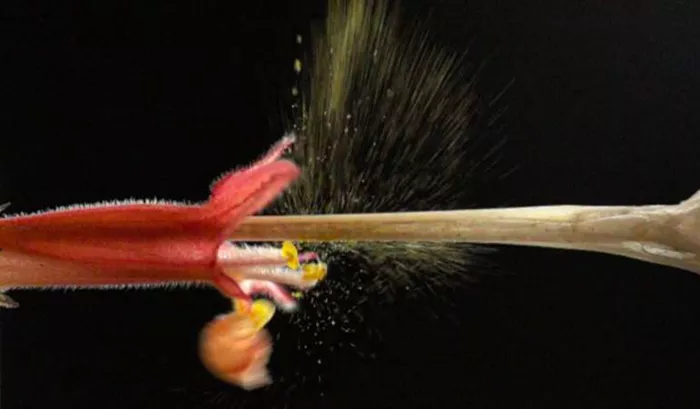Scientists Discover Plant Pollen Competition.
Scientists from South Africa and Brazil have found evidence that pollen grains from different plants may compete for space on pollinators. This competition affects which pollen gets transferred to the next flower.
In a study published in The American Naturalist, researchers argue that plants can influence where and how much pollen sticks to pollinators. They suggest that plants have developed strategies similar to how animals manipulate sperm.
Some animals and insects have evolved special structures on their reproductive organs. These structures help remove the sperm of rival males from females before depositing their own. However, plant reproduction does not involve direct contact between flowers. Instead, pollen manipulation must happen before it reaches another flower, specifically on the bodies of pollinators.
The study focuses on Hypenea macrantha, a red flower found only in Brazil. The researchers set up an experiment, captured in slow-motion video, showing how this flower uses a catapult-like mechanism. This mechanism helps remove pollen from rival flowers that sticks to the bill of a hummingbird. It then deposits its own pollen in the same spot.
The researchers placed pollen grains marked with quantum dots on a hummingbird’s bill and counted them. After the flower used its explosive mechanism, they counted the grains again to see how many were removed. This is the first time researchers have provided clear evidence of how effective this mechanism is in removing rival pollen.
Prof. Bruce Anderson, an evolutionary ecologist at Stellenbosch University, is the first author of the study. He says the findings support the idea that plants can compete for pollen removal.
He explains, “Flowers visited by hummingbirds deposit their pollen on the hummingbird bills. However, there is very little space for new pollen. Flowers have developed a catapult mechanism that shoots pollen onto the hummingbird’s bill. The force of these grains dislodges pollen from rival plants, allowing the flower to place its own pollen onto a cleaner bill. This increases its chances of successful reproduction.”
In other words, showing effective pollen removal through this explosive method supports the idea that competition among male plants may have influenced the evolution of this trait.
Anderson believes this discovery reveals new ways plants may compete with each other. “Until now, no one thought to look for these structures in plants. Flowers from different individuals do not interact directly during mating. This makes it challenging for flowers to manipulate the pollen of other flowers like animals can.”
However, pollen manipulation can happen on pollinators instead of other flowers. Anderson comments, “When a pollinator arrives at a flower covered in rival pollen, it may be hard for the flower to deposit its pollen. The space may be filled with rival pollen grains. Even if the flower succeeds, its chances of reproductive success may be low due to competition with those grains for access to the ovules of the next flower.”
So, what can a flower do? Like animals with special adaptations, it can evolve strategies to clear rival pollen from pollinators before placing its own.
Prof. Vinícius Brito, a botanist at the Federal University of Uberlândia in Brazil and a co-author of the study, notes that floral explosion was previously thought to help place pollen on pollinators or startle them into moving to new plants.
“However, our data suggests that this mechanism may actually remove pollen from previous flowers, improving reproductive success by increasing competition for space on the pollinators’ bodies,” he concludes.
Related topics:
- Mayor Prohibits Cactus Plants in Buildings
- Essential Garden Plants to Plant Now for a Vibrant Autumn Display
- Local Nursery Owner Shows How Native Plants Help Wildlife


